Is a week enough to really see Morocco? I get this question all the time, and my answer is always an enthusiastic yes. While you could spend months exploring every corner of this incredible country, seven days is the perfect amount of time to get a real taste of its magic. The trick is to focus on the classic Imperial Cities and Sahara Desert loop—it's a tried-and-true route for a reason and the most rewarding journey for first-timers.
Planning Your Unforgettable Week in Morocco
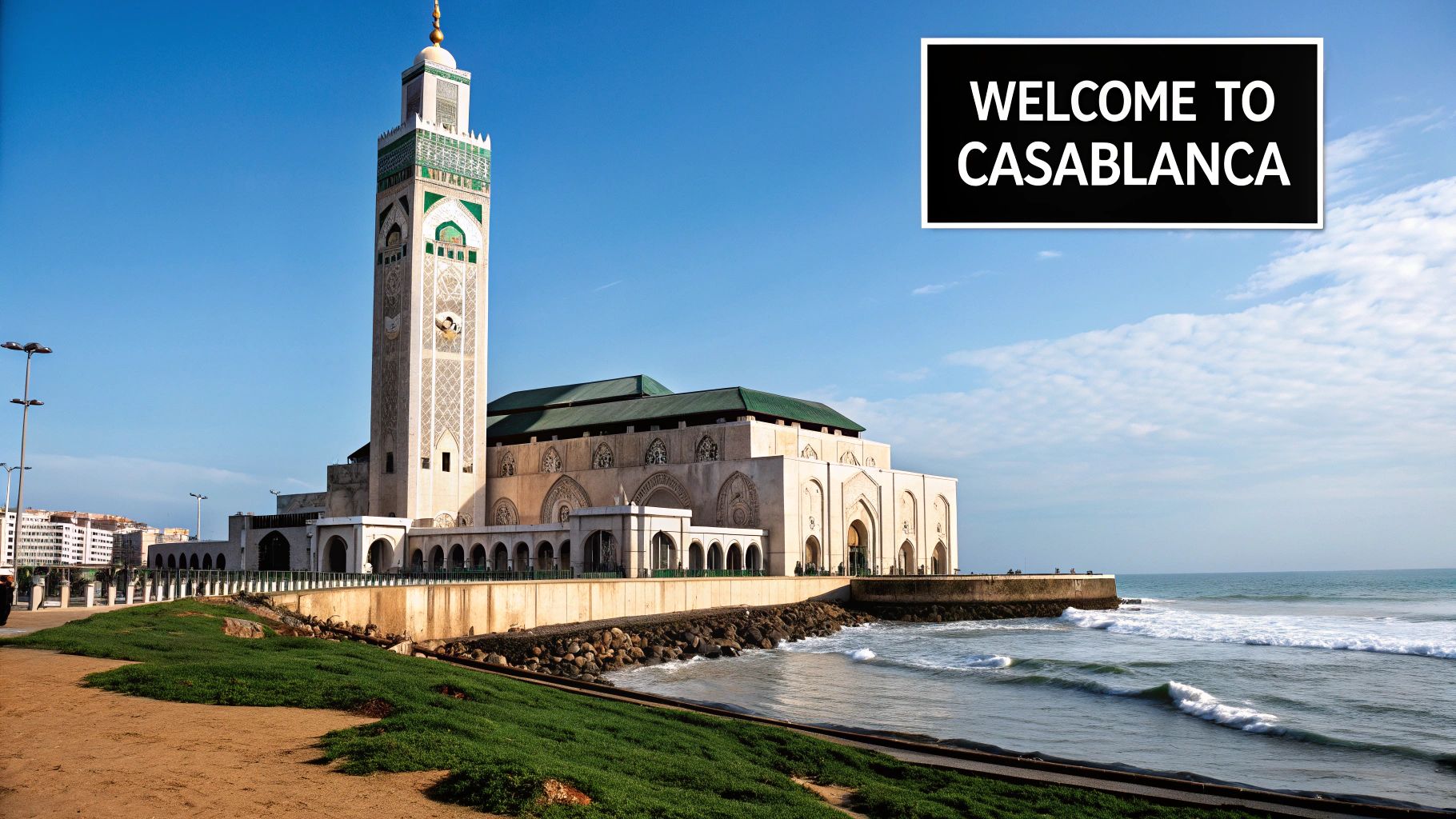
Putting together a one-week trip to Morocco can feel like assembling a beautiful, intricate puzzle. You're working with stunning pieces—ancient medinas, sweeping desert vistas, and the dramatic Atlas Mountains—but you have to make them fit together against the clock of travel time. The secret isn't to rush, but to plan smart. This guide is designed to give you a journey that feels deep and immersive, not like you're just ticking boxes.
It seems the secret is out, too. Morocco’s tourism is hitting record highs, with classified tourist establishments logging over 11.88 million overnight stays by the end of May last year. That’s a 14% jump from the year before, driven mostly by international travelers whose stays shot up by 17%. If you want to dig deeper, you can read more about Morocco's tourism growth and what it means for your trip. This boom shows that the country is more ready than ever to welcome visitors, with infrastructure and experiences that are polished and waiting.
Quick Glance Morocco 7-Day Itinerary
Before we get into the nitty-gritty, it helps to see the big picture. Think of the table below as a highlight reel of your week, outlining the classic route that captures the very essence of Morocco.
This itinerary is structured to give you a logical flow from city to desert and back, making the most of every single day.
| Day | Main Location | Key Activity Highlight |
|---|---|---|
| 1 | Marrakech | Arrival and settling into the vibrant Djemaa el-Fna square. |
| 2 | Marrakech | Exploring the historic medina, souks, and palaces. |
| 3 | High Atlas Mountains | Scenic drive through Tizi n'Tichka pass to Ait Benhaddou. |
| 4 | Merzouga | Camel trek into the Sahara Desert for a night in a desert camp. |
| 5 | Fes | Traveling through the Ziz Valley towards the ancient city of Fes. |
| 6 | Fes | Discovering the world’s oldest university and bustling tanneries. |
| 7 | Fes/Casablanca | Departure or transfer for your flight home. |
As you can see, each stop offers a completely different flavor of the country. This plan is your blueprint for a week that feels like a true adventure, not just a tour. Now, let's break it down day by day.
Why Morocco Is a Must-Visit Destination Now
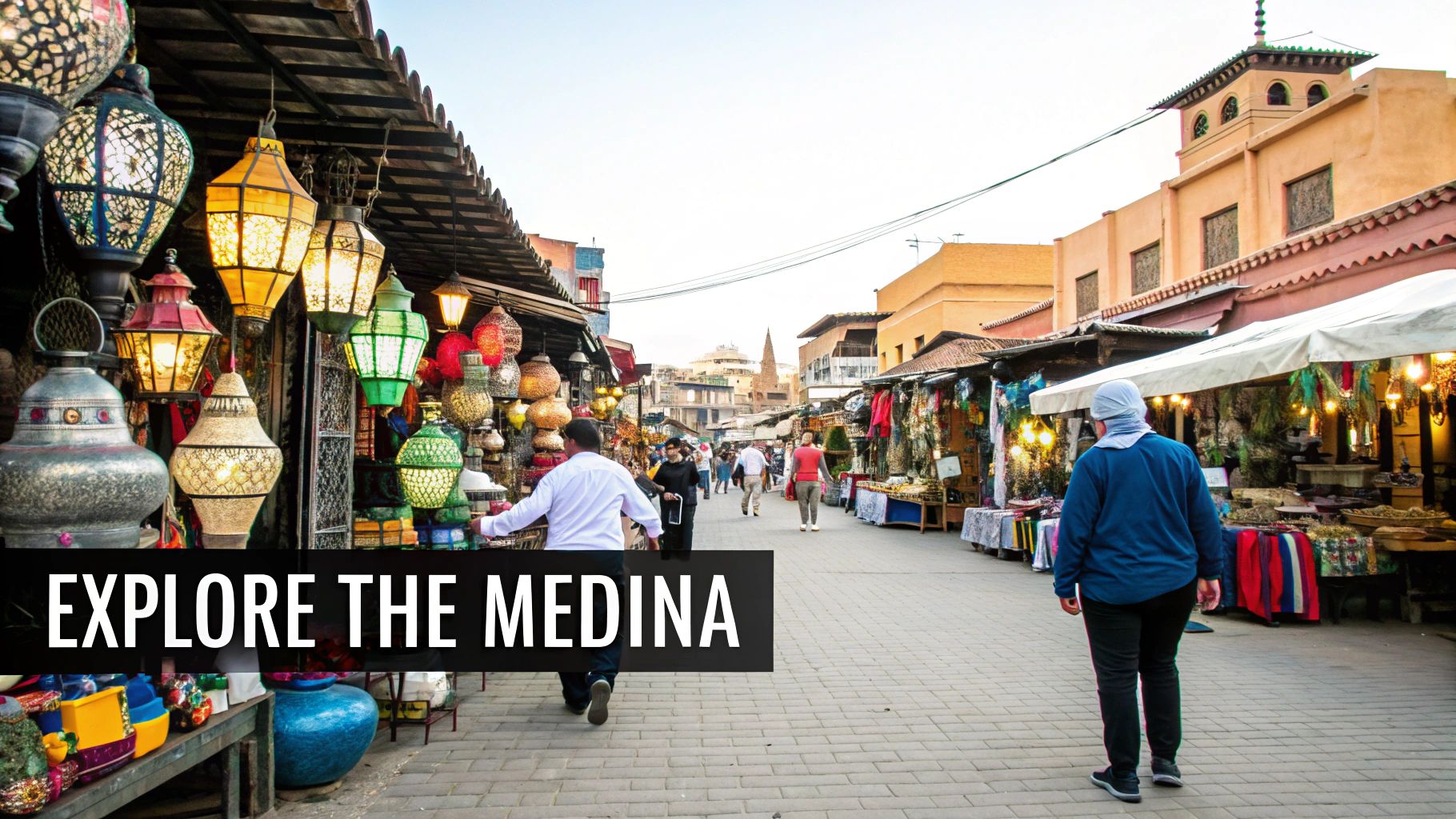
There’s a real energy around Morocco right now. You can feel it. It’s no longer just a backdrop for beautiful photos; it’s a country that’s truly come into its own, making this the perfect moment to visit. Experiencing Morocco now means catching it at the absolute peak of its global appeal.
This isn't by chance. The Moroccan government has been smart, investing heavily to polish the travel experience for visitors. Think of it as a grand theater preparing for opening night—the stage is set, the lighting is perfect, and the doors are wide open. Modernized airports ensure a smooth arrival, and new infrastructure, like Africa’s very first high-speed rail line, has slashed travel times between major cities.
This focus on making the country accessible is clearly working. Morocco is in the middle of a massive tourism boom, cementing its place as one of the top destinations in Africa.
A Destination on the Rise
The recent numbers tell an incredible story. In just the first five months of this year, Morocco welcomed a record-breaking 7.2 million tourists. That's a huge 22% increase from last year and an astounding 68% jump compared to pre-pandemic levels, proving the country's powerful momentum.
A trip to Morocco right now isn't just a vacation; it's a chance to witness a country fully embracing its moment on the world stage. You’re stepping into a place validated by this wave of global interest, where you can expect world-class hospitality and unforgettable experiences.
So, what does this boom mean for your trip?
- Better Infrastructure: Moving between ancient cities and desert landscapes is easier and more comfortable than ever.
- Refined Experiences: From luxury desert camps to authentic city riads, tourism services are well-honed and professional.
- Vibrant Atmosphere: You'll feel the buzz. The country is filled with a palpable sense of energy and optimism.
It's this unique blend of timeless culture and modern convenience that makes planning a trip now such a great idea. For a deeper dive into what makes this country tick, our comprehensive Morocco travel guide has you covered. Trust me, you'll want to be part of this chapter in Morocco’s story.
A Day-By-Day Guide to Your Morocco Itinerary
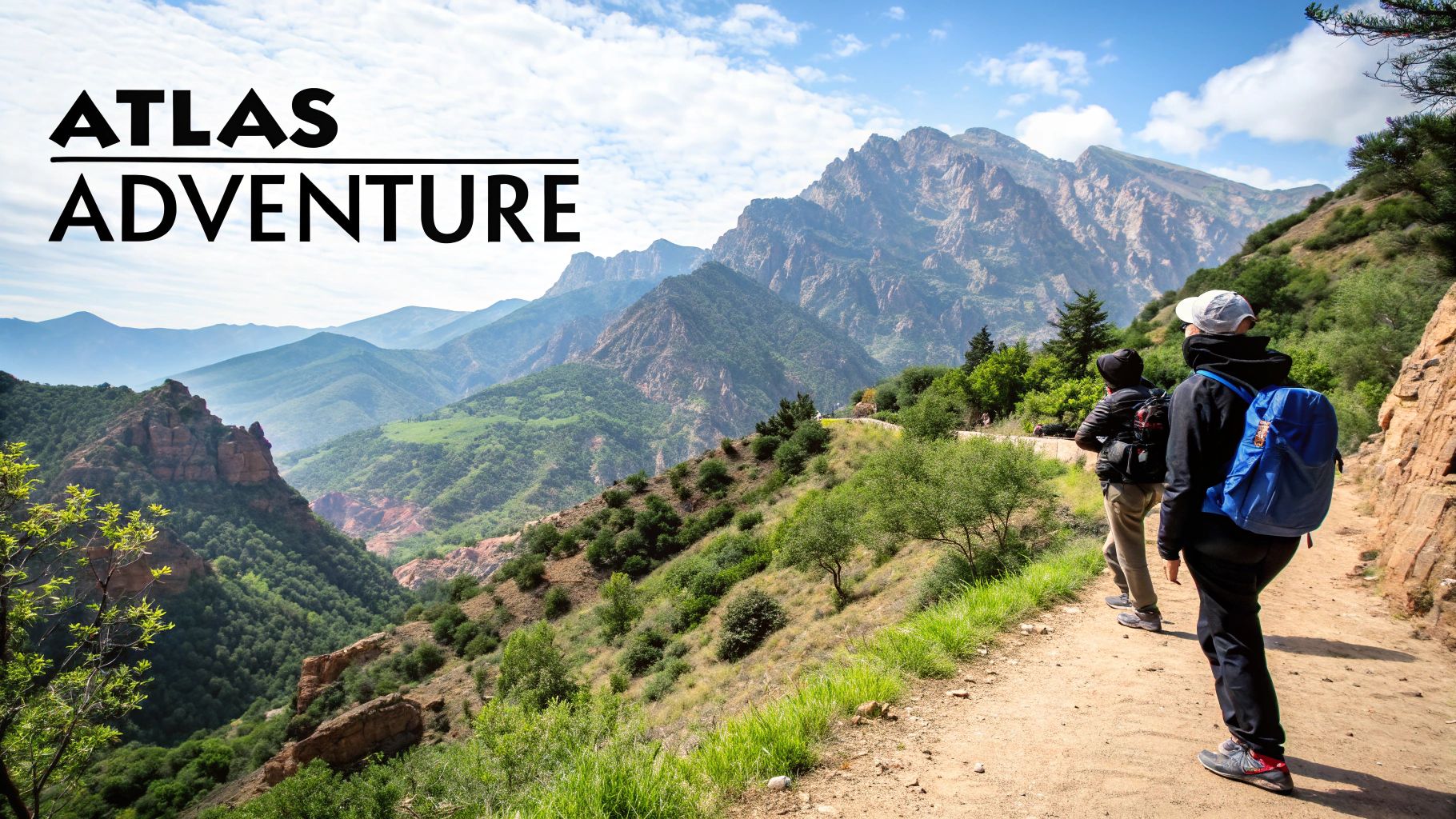
Alright, this is where the real adventure kicks off. I've designed this 7-day Morocco itinerary to be more than just a checklist; it's a journey that pulls you right into the heart of the country. We’ll move from the electric buzz of Marrakech to the profound stillness of the Sahara, finishing in the ancient, scholarly city of Fes.
Think of this plan as a well-worn map from a seasoned traveler. It's built to be efficient so you can see the highlights, but paced so you won't feel rushed, leaving room for those spontaneous, authentic moments. I'll walk you through each step to make sure your Morocco in one week trip is as seamless as it is unforgettable.
Day 1: Arrival And First Impressions In Marrakech
Your plane touches down at Marrakech-Menara Airport (RAK), and the energy of Morocco hits you the moment you step outside. After you’ve sorted customs, you'll meet your pre-booked transfer to your riad—a traditional Moroccan home built around a peaceful inner courtyard. This is your first real taste of the country’s incredible architecture and hospitality.
After settling in, it’s time to head for the legendary Djemaa el-Fna square. As dusk begins to settle, this UNESCO World Heritage site comes alive, transforming into a spectacular open-air carnival that’s unlike anything you've ever experienced.
- Storytellers hold crowds captive with ancient epics.
- Snake charmers pipe out their hypnotic tunes.
- Food stalls billow fragrant smoke, grilling everything from savory meats to classic tagines.
My advice? Find a rooftop café with a view over the square. Order a pot of mint tea, sit back, and just soak it all in. It’s the perfect way to sync up with the rhythm of Marrakech.
Day 2: Exploring The Soul Of Marrakech
Today is all about diving headfirst into the historic medina of Marrakech. The best way to tackle its maze-like alleyways is with a licensed local guide. Their knowledge turns what could be an overwhelming experience into a fascinating walk through centuries of history.
Your guide will likely lead you to several key sites that tell the story of Marrakech’s imperial past.
Key Sights To See:
- Koutoubia Mosque: While you can't go inside if you're not Muslim, its stunning minaret is the city's most famous landmark and an essential point of reference.
- Bahia Palace: A masterpiece of 19th-century Moroccan design. You’ll be blown away by the intricate tilework (zellij), carved plaster, and serene, shaded courtyards.
- Saadian Tombs: These opulent mausoleums, hidden for centuries and rediscovered in 1917, hold the remains of the powerful Saadian dynasty rulers.
After a morning steeped in history, it’s time to lose yourself in the souks. This isn't just shopping; it's a total sensory overload. Each narrow lane is dedicated to a different craft—piles of fragrant spices, buttery leather goods, glowing lanterns, and hand-woven carpets. Don't be shy about haggling; it's a friendly, expected part of the whole cultural exchange.
Pro Tip: Getting a little lost in the souks is half the fun. Seriously. If you ever feel turned around, just look for signs pointing back to Djemaa el-Fna or ask a shopkeeper for directions. They’re almost always happy to point you the right way.
Day 3: Crossing The High Atlas Mountains
Today, you'll trade the city's hum for the raw, dramatic landscapes of the High Atlas Mountains. The drive itself is a highlight, snaking over the famous Tizi n'Tichka pass, which crests at a breathtaking 2,260 meters (7,415 feet). Every turn reveals another jaw-dropping panoramic view of snow-dusted peaks and Berber villages that seem to defy gravity, clinging to the mountainsides.
Your main stop is the ksar of Ait Benhaddou, another one of Morocco's incredible UNESCO World Heritage sites. This fortified village of packed earth looks like it grew right out of the ground. It’s no wonder it's been the backdrop for blockbusters like Gladiator and Game of Thrones.
Walking its ancient, winding streets truly feels like stepping onto a film set from another era. Make sure to climb to the fortified granary at the top for an unforgettable sunset view. You'll spend the night in a converted kasbah nearby, which lets you experience the deep silence of the region once the day-trippers have gone.
Day 4: Reaching The Sahara Desert At Merzouga
The journey pushes east, taking you through Ouarzazate—the "Hollywood of Morocco"—and into the stunning Dadès Valley, often called the "Valley of a Thousand Kasbahs." You'll see the landscape transform before your eyes as rocky plains give way to the first golden hints of sand.
Your final destination for the day is Merzouga, the gateway to the magnificent Erg Chebbi dunes. These are the iconic, rolling dunes you've pictured, some towering over 150 meters high. Here, you'll swap your vehicle for a more traditional ride: a camel.
Led by your guide, your camel caravan will carry you deep into the dunes. It's a slow, rhythmic trek that lets you fully absorb the sheer scale and silence of the Sahara. Watching the sun dip below the horizon, painting the sand in shifting shades of gold, orange, and purple, is pure magic. You’ll arrive at your Berber desert camp for a hearty tagine dinner under a blanket of stars so brilliant they feel close enough to touch.
Day 5: The Long Road To Fes
Waking up before dawn is a must. Seeing a Sahara sunrise, as the first light crests the dunes and casts long, dramatic shadows across the sand, is a profoundly peaceful experience that will stick with you forever.
After breakfast, you'll head back to Merzouga by camel or 4×4 to start the longest drive of the trip. This northbound journey to Fes covers a lot of ground, but the constantly changing scenery makes it fascinating. You’ll travel through the Ziz Valley, a massive oasis where millions of palm trees create a stunning ribbon of green against the arid backdrop.
The route then climbs into the Middle Atlas Mountains, a world away from the desert. You'll pass through cedar forests that are home to Barbary macaque monkeys. A quick stop in Ifrane, a town nicknamed the "Switzerland of Morocco" for its alpine-style architecture, provides a surprising change of pace before you finally descend into the ancient city of Fes that evening.
Day 6: Uncovering Historic Fes
Welcome to Fes, the cultural and spiritual capital of Morocco. Its medina, Fes el-Bali, is one of the world's largest living medieval cities and a protected UNESCO World Heritage site. Today is all about navigating its bewildering and utterly captivating maze of over 9,000 alleys. Trust me on this: hire a local guide. They are essential for making sense of the beautiful chaos and showing you the hidden gems.
Your tour will take you to some truly iconic landmarks:
- Al-Qarawiyyin University: Founded way back in 859 AD, it’s recognized as the oldest continuously operating university in the world.
- Bou Inania Madrasa: A stunning example of Marinid architecture that, unlike many religious sites, is open to non-Muslim visitors.
- The Chouara Tannery: One of Fes's most iconic sights. From a leather shop terrace, you get a bird's-eye view of workers treating hides in huge stone vats of dye—a process that hasn't changed in centuries.
The medina is a living, breathing workshop. You'll hear the constant tap-tap-tap of metalworkers, smell the fragrant cedarwood from the carpenters' shops, and see weavers creating magic on their looms. For travelers who want to tailor this experience, looking into https://topmoroccotravel.com/morocco-private-tours/ offers the flexibility to spend more time in the places that capture your imagination.
Day 7: Departure
Your incredible week in Morocco comes to a close. Depending on when your flight is, you might have time for some last-minute souvenir hunting in the Fes medina or one final Moroccan breakfast at a local café.
You can fly directly out of Fes-Saïss Airport (FEZ) or arrange a transfer to Casablanca's Mohammed V International Airport (CMN), the country's main international hub. As you head home, you’ll be carrying a rich mosaic of memories: the vibrant chaos of the souks, the majestic silence of the desert, and the incredible warmth of the Moroccan people.
How to Plan Your Trip Logistics
Alright, with the day-to-day excitement mapped out, it's time to talk about the practical side of things. Nailing down your transport, accommodation, and budget is what turns a good plan into a seamless, unforgettable trip. Think of it as building the scaffolding for your adventure—get it right, and the rest just falls into place.
This planning is more important than ever, as Morocco is quickly becoming a go-to destination. The country saw 4 million visitors in just the first quarter of this year, a 22% jump from the year before. This isn't just a fluke; it's a sign that North Africa is a major hotspot. You're stepping into a vibrant, in-demand travel scene, which makes a little foresight go a long way.
Choosing Your Ideal Accommodation
Where you stay in Morocco is a huge part of the experience itself. It's not just a bed for the night; it's your gateway into the local culture.
- Riads: These traditional Moroccan homes, tucked away inside the ancient medinas, are built around serene central courtyards. Staying in one is my top recommendation for an authentic feel. They offer a peaceful escape from the bustling streets and a much more personal touch than a big hotel.
- Hotels: If you're someone who needs a gym, a massive swimming pool, or a more conventional hotel setup, you'll find plenty of modern options, especially in cities like Marrakech and Fes.
- Kasbahs: Out in the countryside, particularly near historic sites like Ait Benhaddou, you can stay in a renovated fortress, or kasbah. It’s an incredibly atmospheric choice that connects you directly to the region's rich history.
A quick note on packing: smart packing is crucial for a week-long trip with varied climates. Think durable, comfortable clothing that can handle both city heat and desert cool. Investing in quality gear, even down to the best travel underwear options, can make a real difference in your comfort.
Getting Around Morocco
Let's be realistic: the journey from Marrakech to the Sahara and then on to Fes involves some serious travel time. Choosing your transport is a balancing act between cost, comfort, and, most importantly, time.
The image below really drives home the reality of the Sahara portion of the trip, showing just how much the temperatures can swing and the distances you’ll be covering.
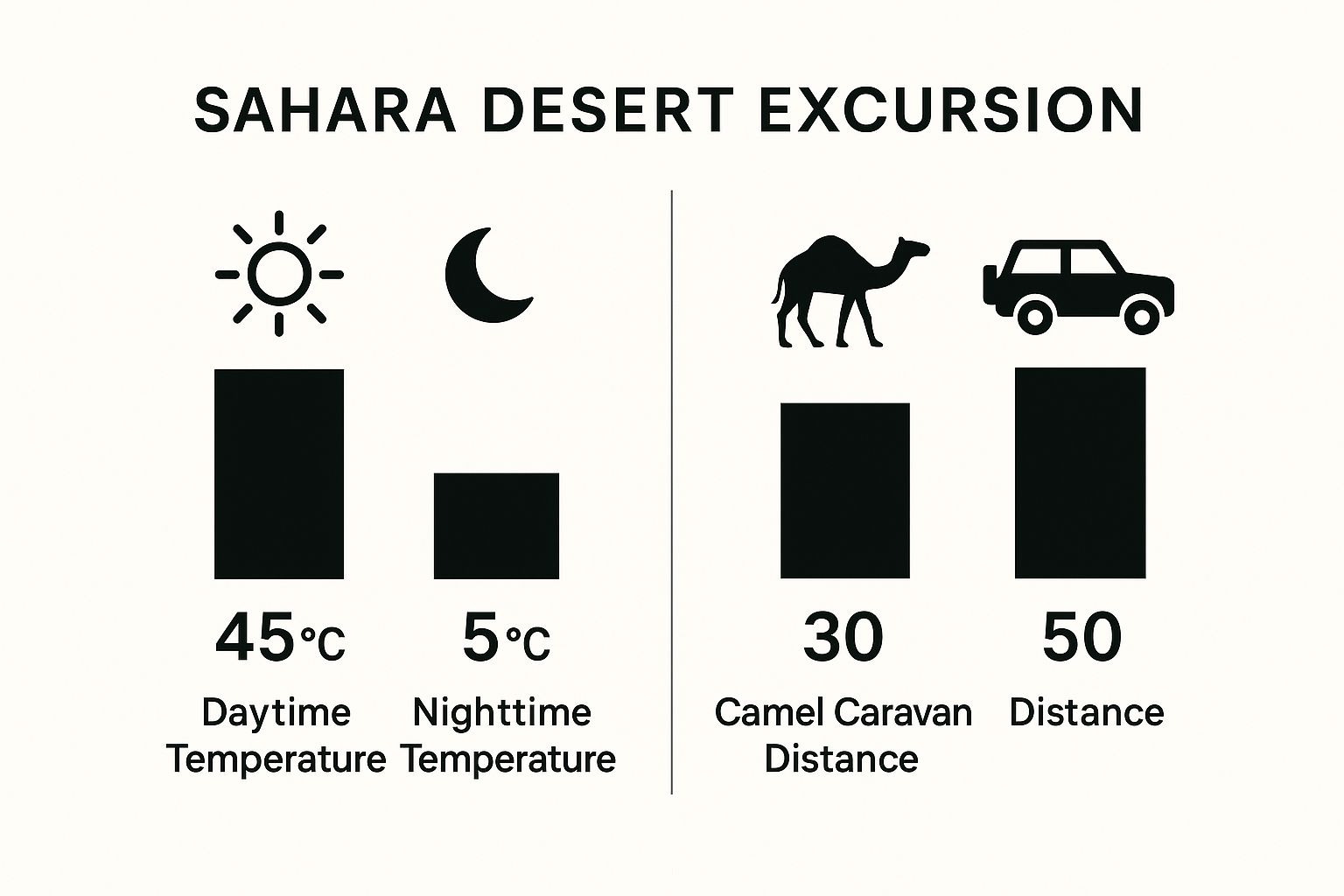
As you can see, the desert is a place of extremes. The data also highlights a key point: a 4×4 vehicle is far more efficient for covering the vast distances compared to a traditional camel caravan.
Key Insight: For a one-week trip, a private driver is, without a doubt, the most efficient way to go. It completely removes the stress of navigating public transport, maximizes your sightseeing time, and lets you soak in the views without worrying about the clock.
If you want a pre-packaged option that handles all the logistics, exploring different Morocco adventure tours is a great way to find a trip that matches your pace and interests perfectly.
To help you decide, here's a quick breakdown of your main transportation choices for this itinerary.
Transportation Options Between Major Cities
| Transport Mode | Estimated Cost (Per Person) | Travel Time (Marrakech to Fes) | Best For |
|---|---|---|---|
| Private Driver/Tour | $400 – $600 (for the 3-day leg) | 3 Days / 2 Nights | Travelers on a tight schedule who value comfort, flexibility, and maximizing sightseeing. |
| Public Bus (Supratours/CTM) | $25 – $40 | 11-12 hours (direct) | Budget-conscious travelers with more time who don't mind missing the Sahara stops. |
| Grand Taxi | Varies (negotiation required) | 9-10 hours (direct) | Small groups who want a faster, more direct option than the bus but without the tour frills. |
Ultimately, a private driver or a small group tour gives you the best bang for your buck on a tight, one-week schedule, ensuring you don't miss the incredible landscapes along the way.
Setting a Realistic Budget
One of the best things about Morocco is that it can accommodate almost any budget, from backpacker-friendly to pure luxury. For a comfortable, mid-range experience, here's a rough breakdown of what you can expect to spend per person.
- Accommodation: $50 – $150 per night for a lovely riad or a mid-range hotel.
- Food: $25 – $50 per day will get you a fantastic mix of cheap-and-cheerful street food and sit-down restaurant meals.
- Transport (Private Driver): Expect to pay $150 – $200 per day for the entire vehicle. When split between a few people, this becomes very cost-effective.
- Activities & Guides: Set aside $20 – $60 per day for museum entries, local city guides, and must-do experiences like the Sahara camel trek.
This adds up to a realistic daily budget of around $150 – $250 per person, not including your flights. Planning for these costs upfront means you can book your trip confidently, free from any budget-related stress while you're there.
Navigating Moroccan Culture and Customs
To get the most out of your one week in Morocco, it helps to have a little cultural know-how. This isn't about memorizing a long list of rules; it's about moving with respect and awareness, which opens the door to far more genuine connections with the people you meet.
Think of it as the difference between just looking at Morocco and actually experiencing it. From the chaotic energy of the souks to a quiet moment in a mountain village, a little insight goes a very long way. Here’s some practical advice to help you navigate your journey with confidence.
Understanding Local Etiquette
At its heart, Moroccan culture is built on hospitality, deep-rooted traditions, and mutual respect. Keeping a few key customs in mind will be warmly appreciated by everyone you encounter.
- Greetings: A simple and friendly "Salam" (peace) works wonders as a respectful greeting. If someone offers their right hand for a handshake, it’s polite to accept.
- Use Your Right Hand: This is a big one. Always use your right hand for eating, shaking hands, and passing items to others. In traditional Islamic culture, the left hand is reserved for personal hygiene and is considered unclean.
- Photography: Morocco is a photographer's dream, but it's crucial to be respectful. Always ask permission before taking a close-up photo of someone. Many people, particularly in more traditional or rural areas, prefer not to be photographed.
Key Takeaway: The foundation of Moroccan etiquette is simply respect. A warm smile, a bit of patience, and a genuine attempt to be polite will smooth over any small cultural missteps. It’s about the effort, not perfection.
The Art Of Haggling In The Souks
Don't think of bargaining in the souks as a confrontation. It’s an age-old social custom, a friendly dance that’s an expected—and often enjoyed—part of the transaction. The first price you hear is just an opening offer, the start of a conversation.
The trick is to approach it with a light heart and a smile. Before you even start, decide in your own mind what the item is worth to you. A good starting point for your counteroffer is often around 50% of the initial asking price. Enjoy the good-natured back-and-forth. If you can't land on a price you're both happy with, just say "Shukran" (thank you) and politely walk away. You'd be surprised how often that final move brings the vendor back with the price you wanted.
Dress Code And Respectful Attire
As a predominantly Muslim country, Morocco leans toward conservative values. Dressing modestly is a simple yet powerful sign of respect, especially when you're visiting religious sites or venturing into rural areas. For both men and women, this generally means keeping your shoulders and knees covered.
Loose linen pants, long skirts, and comfortable t-shirts or blouses are your best friends here. Not only are they respectful, but they’re also incredibly practical for staying cool in the Moroccan heat. For women, a lightweight scarf is an essential, multi-purpose accessory—perfect for covering your head if you enter a mosque that permits visitors, or for simply shielding yourself from the sun. This respectful approach is just as important in the bustling cities as it is when you’re relaxing at one of the beautiful luxury desert camps in Morocco.
Health, Safety, And Food Choices
Tasting your way through Morocco is one of the trip's greatest joys. The street food can be fantastic, but a good rule of thumb is to eat where the locals are. A busy stall is usually a great indicator of fresh, high-quality food. As for water, play it safe and stick to bottled water to avoid any potential stomach upsets.
Diving into the local culture also means appreciating the culinary traditions. If you're curious, it can be enriching to learn more about understanding halal food principles, such as those concerning gelatin. This kind of knowledge adds a whole new layer to your experience at the dinner table.
Common Questions About Visiting Morocco for a Week
Planning a trip to a place as rich and layered as Morocco always stirs up a lot of questions. It's completely normal to want to get the details right—after all, it's the little things that often make the biggest difference on a journey.
Let's walk through some of the most common queries I hear from travelers. We'll cover everything from timing your visit to navigating the ancient city streets, so you can head off on your adventure feeling confident and fully prepared to soak it all in.
Is One Week Really Enough for Morocco?
This is probably the number one question people ask, and it’s a fair one. The honest answer? It depends on what you're hoping for. Will you see the entire country in seven days? Of course not. But can you have a rich, unforgettable, and truly immersive experience? Absolutely.
A week gives you just the right amount of time to tackle the classic Morocco circuit: Marrakech, the Sahara Desert, and Fes. There's a reason this route is so beloved—it serves up a perfect taste of the country's incredible diversity without feeling like a mad dash. You get the buzz of the imperial cities and the soul-stirring silence of the desert.
By focusing on this well-trodden path, you aren't just skimming the surface. You're diving deep into three of Morocco's most iconic and contrasting landscapes, which is far more rewarding than trying to see a little bit of everything.
What Is the Best Time of Year to Visit?
While you can technically visit Morocco any time of year, most seasoned travelers will tell you the shoulder seasons offer the best experience.
- Spring (March to May): This is when the country comes alive. Everything is lush and green, and the temperatures are just right for wandering through the cities or hiking in the mountains.
- Autumn (September to November): The intense summer heat has finally broken, leaving behind gloriously warm, sunny days and pleasantly cool evenings. This is arguably the most popular window for a trip.
Summer (June to August) can be incredibly hot, especially in Marrakech and out in the Sahara. On the flip side, winter (December to February) brings cooler weather and even snow to the Atlas Mountains, though the main cities remain quite mild. For a more detailed look, you can learn all about the best time to visit Morocco to perfectly match your trip to the climate you prefer.
Do I Need to Hire a Guide for the Medinas?
You can certainly wander on your own, but I always recommend hiring a licensed local guide, at least for your first day in a medina like Fes or Marrakech. These ancient city centers are mesmerizing labyrinths, with Fes alone containing over 9,000 winding alleyways. It's easy to get turned around.
A good guide does so much more than just keep you from getting lost. They breathe life into the history, share the cultural stories behind what you're seeing, and lead you to hidden gems—artisan workshops, tranquil courtyards—that you would almost certainly miss on your own. It turns what could be an overwhelming maze into a fascinating adventure.
Is Morocco Safe for Solo Female Travelers?
Yes, Morocco is generally a safe place for women traveling alone, but like anywhere in the world, it calls for a bit of awareness and common sense. Moroccan hospitality is legendary, and countless women explore the country solo every year without a single issue.
To make sure your experience is a great one, just keep a few tips in mind:
- Dress Modestly: Covering your shoulders and knees is a simple sign of respect that helps you blend in and minimizes unwanted attention.
- Be Confident: Walk with purpose and don't be afraid to be firm (but always polite) if you need to turn down an offer or end a conversation.
- Book Reputable Riads: Sticking to well-reviewed accommodations in good areas gives you a secure and welcoming home base to return to each day.
Thousands of women have incredible, life-changing solo trips in Morocco every year. With a bit of mindfulness and preparation, you can be one of them.
At Top Morocco Travel, we specialize in crafting personalized journeys that match your travel style perfectly. We handle all the logistics, from expert local guides to comfortable transport and hand-picked accommodations, so you can immerse yourself in the magic of Morocco worry-free. Start planning your dream trip with us today.
Article created using Outrank



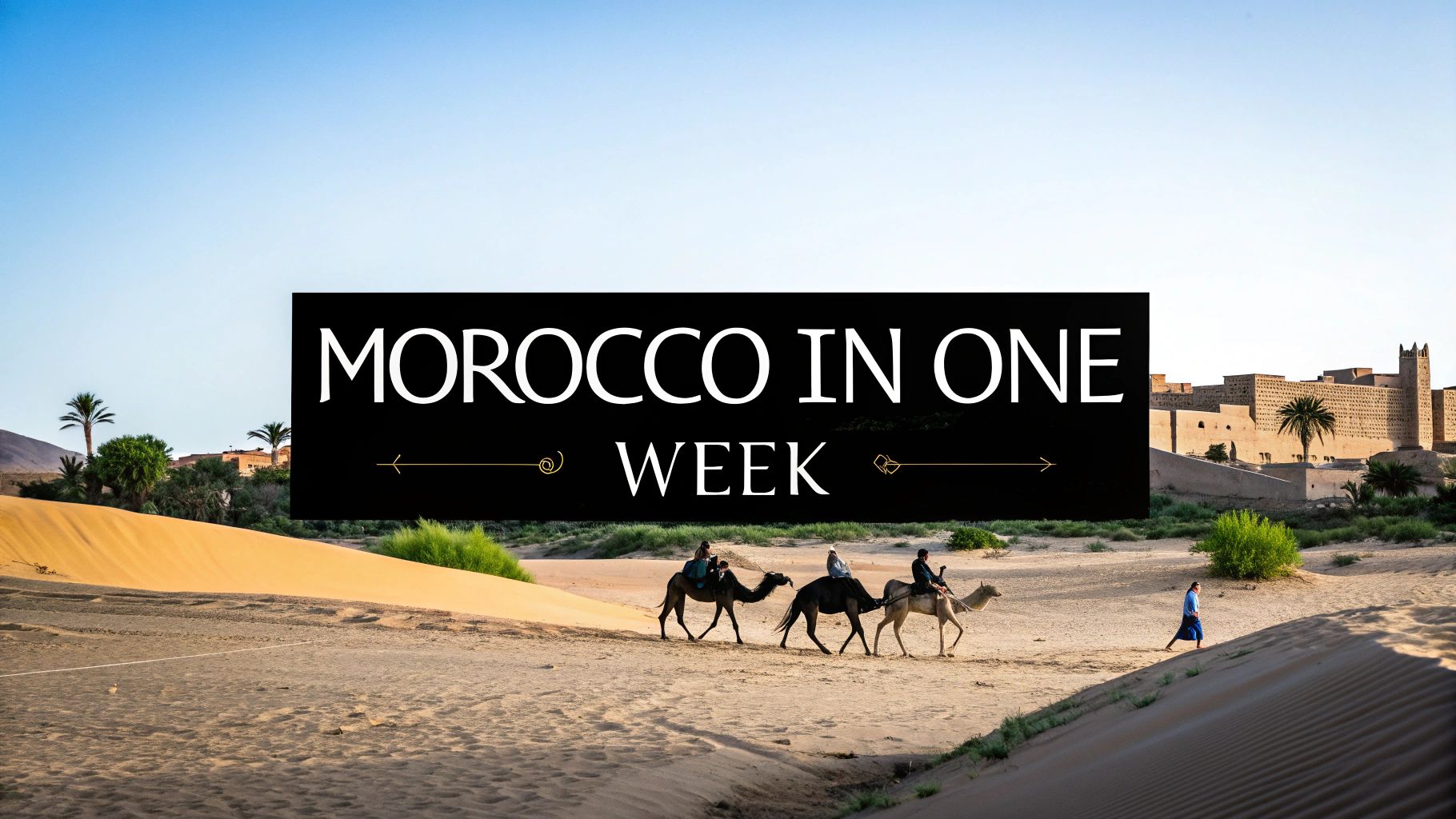


Comments are closed